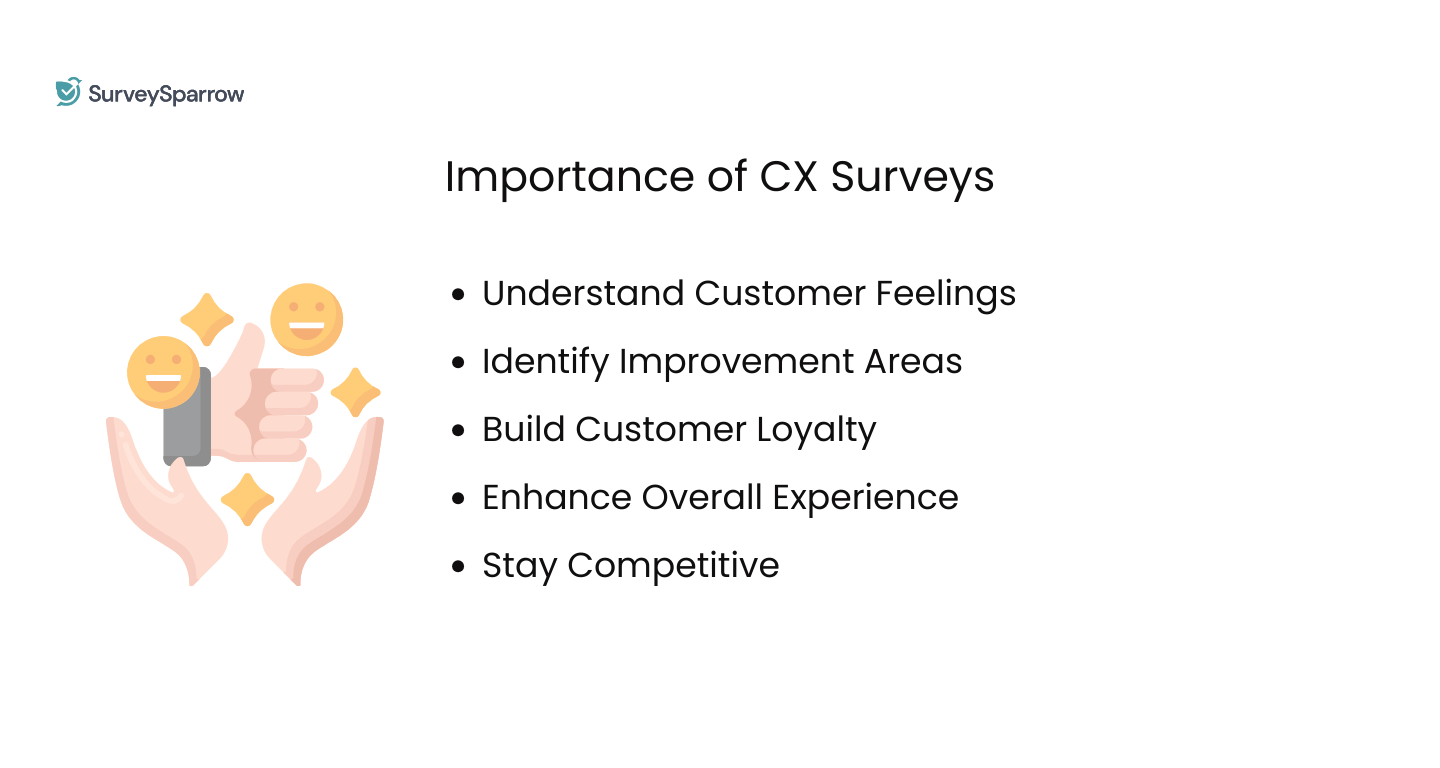A genuine connection is paramount to providing a healthy CX, like any relationship. Listening intently and catering to your customer’s needs is the only way! But how do we do it? One great way to crack this is by using customer experience surveys!
In this blog, we will look into all you need to know about a CX survey, including its importance, types, and best practices to follow.
Off we go!
What is a Customer Experience Survey?
A Customer Experience Survey is a systematic method businesses employ to collect and analyze feedback from their customer base.
It is like a friendly chat with your customers (but on paper or online.) It’s not just any chat. It’s a strategic conversation.
The primary goal? To glean insights into customers’ perceptions, expectations, and satisfaction levels regarding the products or services offered.
When you send out a customer experience survey, you ask customers to share their thoughts, opinions, and experiences with your brand.
It’s a direct line to understanding their satisfaction levels, what they love about your offerings, and where you might fall short.
These surveys often cover various aspects, from the initial buying experience to post-purchase support. By tapping into the customer’s perspective, you gain insights that can guide decisions to enhance products, services, and overall satisfaction.
Read More: Customer Experience Journey
Types of Customer Experience Surveys
There’s no one-size-fits-all approach to customer experience surveys. They come in different types.
Businesses often rely on specialized survey metrics when gauging customer satisfaction and loyalty. Let’s delve into three popular ones:
- Net Promoter Score (NPS)
- Customer Satisfaction Score (CSAT)
- Customer Effort Score (CES)
…and see how they align with various types of customer experience surveys.
| Survey Type | Key Aspects | Examples |
|---|---|---|
| Transactional | Immediate, Specific Event Feedback | Restaurant Survey, Hotel Guest Satisfaction Survey |
| Relational | Periodic, Holistic Relationship Assessment | Customer Effort Score Survey, Customer Onboarding Questionnaire |
| Customer Journey | Touchpoint-specific Overall Experience | Website Intercept Survey, Rate My Website Chatbot |
| Post-Interaction | Prompt Follow-ups, Instant Satisfaction | Post Purchase Survey, Webinar Feedback Form |
1. Transactional Surveys
Transactional surveys are versatile and can incorporate NPS, CSAT, and CES. They capture feedback immediately after a specific transaction, interaction, or event.
Example:
After a customer completes a purchase, a business may utilize a transactional survey that includes questions for both NPS (“How likely are you to recommend us?”), CSAT (“How satisfied are you with your purchase?”), and CES (“How easy was it to complete your purchase?”).
Now, Let’s assume you’re into hospitality. Here are some customer experience surveys you can send out:
2. Relational Surveys
Relational surveys are broader and cover the overall relationship between the customer and the brand. NPS, CSAT, and CES can be integrated periodically for a comprehensive view.
Example:
A quarterly relational survey might include NPS (“How likely would it be for you to recommend us overall?”), CSAT (“How satisfied are you with our overall service?”), and CES (“How easy is it to do business with us in general?”).
Here are some relational customer experience surveys you can roll out:
Read More: Transactional NPS vs Relational NPS
3. Customer Journey Surveys
How do they align? Customer journey surveys can incorporate NPS, CSAT, and CES at various touchpoints to assess the overall experience.
Example:
At each significant touchpoint in the customer journey, surveys may include NPS (“How likely are you to continue with us after this stage?”), CSAT (“How satisfied are you with this specific aspect of the journey?”), and CES (“How easy was it to accomplish your goal at this stage?”).
If you have a website (which you must), roll out a website intercept survey or include a rate my website chatbot.
4. Post-Interaction Surveys
Post-interaction surveys act as quick follow-ups after you engage with a business. These CX surveys can include NPS, CSAT, and CES to measure satisfaction and ease immediately after specific interactions.
Example:
After a customer support call, a post-interaction survey may ask NPS (“How likely are you to recommend us based on this support experience?”), CSAT (“How satisfied are you with the support you received?”), and CES (“How easy was it to get the help you needed?”).
For instance:
Importance of Customer Experience Surveys

- Understand Customer Feelings: Customer satisfaction surveys reveal how customers feel about your products or services, helping you grasp their sentiments firsthand.
- Identify Improvement Areas: Spot areas that need a little extra love. Survey feedback guides you in pinpointing and fixing specific aspects customers find lacking.
- Build Customer Loyalty: Happy customers stick around. By addressing concerns highlighted in surveys, you show customers you care, fostering loyalty and long-term relationships.
- Enhance Overall Experience: Use survey insights to tweak and polish. Improving the customer experience boosts satisfaction, turning one-time buyers into repeat customers.
- Stay Competitive: Customer satisfaction is a differentiator in a crowded market. Surveys keep you in the game by helping you meet or exceed customer expectations.
5 Must-Use Customer Experience Survey Questions
1. How likely would it be for you to recommend our product/service to a friend or colleague?
This Net Promoter Score (NPS) question gauges overall satisfaction and loyalty. Respondents are categorized as Promoters, Passives, or Detractors, providing a clear indicator of brand advocacy.
2. On a scale of 1 to 10, how satisfied are you with your recent interaction/purchase?
A classic Customer Satisfaction Score (CSAT) question measures immediate satisfaction. The simplicity of the scale encourages quick responses, providing actionable insights.
3. What was the primary reason for choosing our product/service?
This open-ended question delves into customer motivations, offering valuable insights into what aspects of your offerings resonate most with your audience.
4. How easy was accomplishing your goal with our product/service?
This Customer Effort Score (CES) question assesses the ease of the customer journey. It helps identify areas where improvements can be made to streamline processes.
5. Is there anything specific you believe we could improve upon to enhance your experience?
An open-ended question invites customers to share constructive feedback. It provides qualitative data on aspects that structured questions may not cover, offering deeper insights for improvement.
Customer Experience Survey Best Practices
To get the perfect results, you need to follow some healthy practices. Here are some things you must do:

1. Clarify Your Objectives:
Clearly outline the goals of your survey. Whether measuring overall satisfaction or pinpointing specific pain points, having defined objectives ensures focused and actionable results.
2. Keep Surveys Concise:
Respect your customers’ time by keeping surveys short and to the point. A concise survey encourages higher participation rates and more genuine responses.
3. Choose the Right Timing:
Time your surveys thoughtfully. Consider sending transactional surveys immediately after an interaction for fresh insights. At the same time, relational surveys can be periodic to gauge long-term satisfaction.
4. Utilize a Mix of Question Types:
Diversify your question types. Combine closed-ended questions for quantitative data with open-ended questions for qualitative insights, providing a comprehensive view of customer sentiments.
5. Focus on User-Friendly Design:
Ensure your survey is visually appealing and easy to navigate. A user-friendly design encourages engagement and contributes to a positive survey-taking experience.
6. Personalize Survey Interactions:
Use customer data to personalize surveys. Address respondents by name and tailor questions based on their history, demonstrating their feedback is valued.
7. Communicate Survey Purpose:
Communicate why you’re conducting the survey and how the feedback will be used. Transparency builds trust and encourages honest responses.
8. Offer Incentives (if Applicable):
Consider providing incentives to boost participation. Rewards, discounts, or exclusive access can motivate customers to share their thoughts.
9. Do Thorough Pre-launch Testing:
Test your survey internally to catch any glitches or confusing elements. A smooth, error-free survey ensures accurate data collection.
10. Act on Feedback:
Show customers their feedback matters. Act on the insights gained from surveys, implementing changes that directly address concerns or enhance positive aspects of the customer experience.
Now.. are you thinking…
Which Tool Should I Use for Customer Experience Surveys?
Selecting the right tool can significantly impact the effectiveness of your efforts.
Consider SurveySparrow, if you’re looking for conversational surveys! The platform lets you create, share, collect, analyze, and act upon the insights you gained, all in the same place!
Why SurveySparrow?
- Talk, Don’t Survey: With SurveySparrow, surveys feel more like a chat, keeping respondents engaged and making feedback more genuine.
- Simple to Use: It’s easy for anyone to create, send, and analyze surveys without needing tech skills.
- Smart Questions: It tailors questions based on previous answers, ensuring a personalized survey experience and getting more relevant insights.
- Multichannel Distribution: Reach your audience through various touchpoints—email, website, or mobile apps.
Fits Your Budget: It has flexible pricing so businesses of all sizes can benefit without breaking the bank. A forever-free plan is available. The basic plan is $19 per month.
Try it out for free!
Create conversational surveys with SurveySparrow
Get 40% more responses
- 14-Day Free Trial
- • Cancel Anytime
- • No Credit Card Required
- •Need a Demo?
Wrap Up!
Customer Experience Surveys are more than just questions. They’re the key to understanding and improving how customers feel. Businesses can improve and create experiences that customers love by listening to their feedback.
So, whether it’s a quick chat-style survey or a thoughtful set of questions, embracing CX Surveys is the way forward. You see, it’s not just about data but also about building better connections with the people who matter most—our customers.
Ready to make your customer experience even better? Start asking, start improving.






